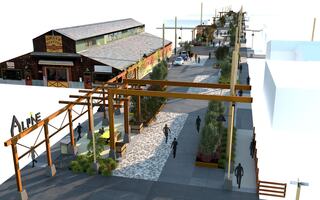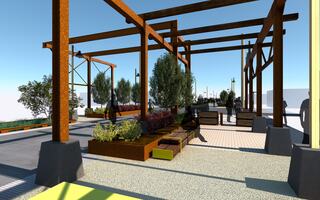The future is bright with AR and VR technologies

SERA has been involved in some pretty complex, multilayered corporate planning and streetscape projects. Endeavors like The Village at Lagoon Valley in Vacaville, the Eugene Riverfront District Master Plan in Eugene, and Alpine Avenue in McMinnville require great understanding of the site, its limitations, and its potential new uses.
Virtual reality (VR) and augmented reality (AR)—once relegated to the marketing department—have now become essential tools to inform and enhance the design process by providing new perspectives. New technologies allow stakeholders to become part of the unfolding story as they step into the space and navigate it wearing VR headsets.

The SERA Visualization group brings together storytellers, digital modelers, software engineering, and traditional computer rendering to enhance the design process and improve decision-making. Together with architectural and urban designers, the Viz team creates opportunities to see projects in new ways and from new perspectives, elevating each project and the firm as a whole.
The results of this collaboration are as varied as the people who contribute. The Viz team has produced content outside a design firm’s typical offering, including district-scale augmented reality experiences, choreographed lighting for building facades, music videos, and client/stakeholder promotional interviews.
Understand, visualize, and design
VR and AR technologies help to resolve differences between designers, clients, and community members by giving everyone a better understanding—not only of the plans themselves, but also how the plans resolve issues specific to the site, including site elevation, the scale of the space, and the progression of the spaces being designed.
The Alpine Avenue Streetscape is a perfect example. A 360 video helped city officials experience the space on VR devices at a project meeting, which completely transformed their understanding of and enthusiasm for the project. The design team also used video interactively to study and make design decisions about features like trellis height.

“We have photos of clients putting on goggles and then, within a few seconds, a huge grin comes over their faces as they can finally see what we’ve been talking about for all these months,” said Brian Stevens, Lead Visualization Specialist, at SERA. “We’re able to move things around, change colors, change some textures, and suddenly we are designing together in a three-dimensional world.”
Create a common vision, from the beginning
VR experiences generate buy-in and enthusiasm with stakeholders at the same time that they enhance the design process. There’s nothing like VR for getting people invested in a space. When people experience visual cues to the things they see and experience every day, they connect with the space, and the project, in an incredibly meaningful way. These experiences equip clients and stakeholders to understand and engage with the design process more confidently. A common language is developed and deeper conversations about project goals and the nature of space become possible.
Large projects like the Eugene Riverfront District Master Plan in Eugene must employ every advantage to build common understanding. Static designs and renderings can illustrate different options, but only from a specific vantage point. VR and AR technologies allow viewers to traverse the site and view it from a variety of perspectives. This video gave clients and partners a chance to travel down 5th Avenue in Eugene, recognizing familiar features and identifying how the project would refresh and renew the space.
VR and AR can even simulate changing daylight and illustrate how light bounces off surfaces and changes from moment to moment throughout the day. A material that looks good in renderings might appear muddy and dull on a cloudy afternoon.
Re-visioning the present by understanding the past
Sometimes the best way to understand a site is to contrast the past, present, and future incarnations of the space. VR and AR let stakeholders peer into the past and then look into the proposed future, while remaining rooted in the present. The technologies level the playing field and improve decision-making by giving everyone the same information, the same experience, and a historical perspective they wouldn’t be able to access otherwise.
A great example is the pro-bono Vanport Placemaking Project. Every year during the Rose Cup Races at the Portland International Raceway (PIR), Vanport sets up a booth where people can have an AR experience of the land that they’re standing on. People can see a live overlay of the space as it used to exist, before the destruction of the Flood of 1948. This simultaneous experience of the past and the present enriches users’ understanding of place, making the historical immediately relevant to the modern day.
Because people use their own handheld devices, the experience is accessible and familiar, further contributing to the user’s natural understanding of the space.
This accessibility is a key ingredient in the magic that SERA’s Viz Team creates. They like for people to use their own devices, accessing the VR experience through a QR code, rather than downloading an app. The team itself takes a minimalist approach to hardware and setup. Using a rig that fits into a large backpack with laptop, headset, and controllers means it’s up and ready to use with little effort, and therefore gets used more frequently.
We’re excited to find even more uses for this technology as it becomes easier to use and more integrated into our project workflows. The more we use it, the more we’ll realize even more possibilities.

